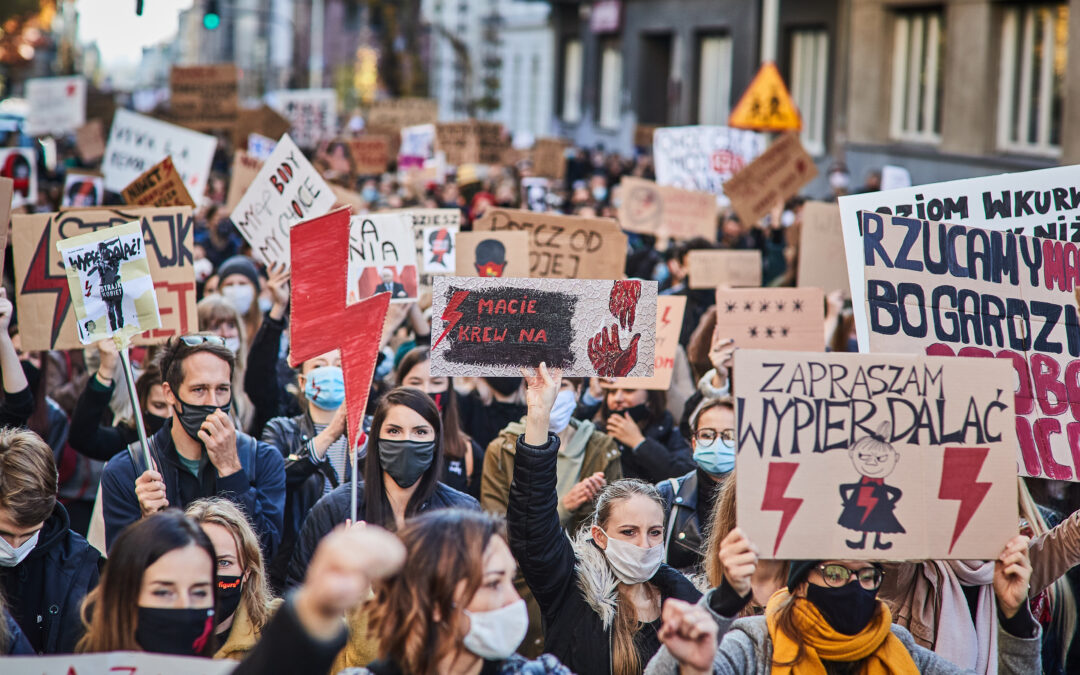New research has shown that young Poles are more likely to hold left-wing views than centrist or right-wing ones for the first time in Poland’s post-communist history. The finds also show growing engagement in politics among the young.
CBOS – a state-linked research agency – has been conducting polling on the political views of young Poles (aged 18 to 24) since 1990, the year after the collapse of Poland’s communist regime.
In its latest survey, conducted last year, it found that 30% in that age bracket declared that they held left-wing views – up from 17% in 2019 and the highest level every recorded.
It is also the first time that those with a left-wing outlook have been more numerous than young people who say they are right-wing (27%) or centrist (23%). The proportion of centrists was down 5 percentage points from 2019 and reached its lowest ever level.
W 2020 roku odsetek młodych Polaków (18-24 lata) o poglądach lewicowych wzrósł w stosunku do poprzedniego roku niemal dwukrotnie, osiągając najwyższy poziom w historii naszych badań (30%). Po raz pierwszy od niemal 20 lat lewicowe sympatie przeważały w tej grupie nad prawicowymi. pic.twitter.com/wWUIIj36OZ
— CBOS (@CBOS_Info) February 8, 2021
Among Poles of all ages, however, 37% declared right-wing views (the highest result ever recorded) while those with left-wing beliefs rose from 17% to 20%.
Among young Poles, those who say they have a very strong interest in politics doubled between 2019 and 2020 (from 2% to 4%) while those who have a strong interest increased from 9% to 14%.
That combined figure of 18% of young people with a strong or very strong interest in politics was not far below the figure for the entire population, 21%, which was itself the highest recorded by CBOS in three decades, reports Gazeta Prawna.
Asked if they would vote were an election to be held on the coming weekend, 79% of respondents said that they would – also the largest figure found by CBOS since they started asking the question in 1989 (the year of Poland’s first semi-free elections). The proportion of young Poles intending to vote jumped from 67% to 77%, also a record.
CBOS’s findings come after a period in which many young Poles have found themselves exceptionally engaged in politics, and in particular in opposition to the ruling national-conservative Law and Justice (PiS) party.
Since last autumn, mass protests have been held in response to the introduction of a near-total ban on abortion. Participants in the demonstrations – which are the largest in Poland since the communist period – have been disproportionately young.
Their anger has also been directed against the Catholic church, which has long been pushing for a ban on abortion and is seen as having close ties with PiS. Another recent poll found that among young Poles, only 9% view the church positively.
Research has, however, shown a longer-term trend in Poland towards young people moving both leftwards and rightwards on the political spectrum. There is also a gender divide, with young women holding more socially liberal and left-wing views and young men expressing more conservative, right-wing ones.
Exit polls from the 2019 parliamentary elections show that the youngest voters (18-29) were more likely to support the left or the far right than any other age group. One fifth of the young voted for the far-right Confederation (Konfederacja) party, three times more than did so in any other age group.
In the first round of last year’s presidential election, exit polls showed that the far-right candidate, Krzysztof Bosak, finished second among voters aged 18 to 29. He received 23% of their support, only narrowly behind the centrist Rafał Trzaskowski (24%).
The left-wing candidate, Robert Biedroń, got 7% of the young vote according to the exit poll, more than double his overall support.
#Exitpoll shows far-right Confederation getting 20% of the vote among those aged under 30, only narrowly behind PiS and KO.
Among young men, who disproportionately support Confederation, it may turn out to have been the most popular party https://t.co/JHgCtl7QXX
— Notes from Poland 🇵🇱 (@notesfrompoland) October 13, 2019
In 2019, polling by Kantar of Poles aged 18 to 30 found a strong split in attitudes between young men, who were more nationalist and traditionalist, and young women, who held more liberal and progressive views.
Among young men, the most popular party was Confederation, while among their female counterparts it was a tie between the liberal-left Spring (Wiosna) and the centrist Civic Platform (PO).
Support for same-sex civil partnerships among young women (73%) was significantly higher than for men of the same age (49%), while young men expressed stronger eurosceptic and antisemitic views than women.
Support for same-sex:
– civil partnerships: men 49%, women 73%
– marriage: men 36%, women 59%Agree that:
– 'man's role is to work and take care of family': men 78%, women 53%
– 'you need to beware of Jews': men 30%, women 19%
– Poland should leave the EU: men 19%, women 8%
3/5— Notes from Poland 🇵🇱 (@notesfrompoland) May 2, 2019
Another poll by Ipsos in the same year found that, among Poles aged under 40, 36% of women expressed left-wing or centre-left views while 31% were on the right or centre-right. Among young men, the figures were 21% and 54% respectively.
Only 12% of young women and 8% of young men saw themselves as centrists.
The same survey found that men under 40 perceived “gender ideology and the LGBT movement” as the greatest threat facing Poland. Among young women, the most cited fear was the climate crisis.
Polish men aged under 40 regard the LGBT movement and 'gender ideology' as the greatest threat to Poland, according to an IPSOS poll.
Among women of the same age the biggest fear is a climate crisis.
Via @oko_press: https://t.co/MONCtk2zr2 pic.twitter.com/jqjCwQNqQD
— Notes from Poland 🇵🇱 (@notesfrompoland) September 17, 2019
Main image credit: Tomasz Stanczak / Agencja Gazeta

Daniel Tilles is editor-in-chief of Notes from Poland. He has written on Polish affairs for a wide range of publications, including Foreign Policy, POLITICO Europe, EUobserver and Dziennik Gazeta Prawna.



















